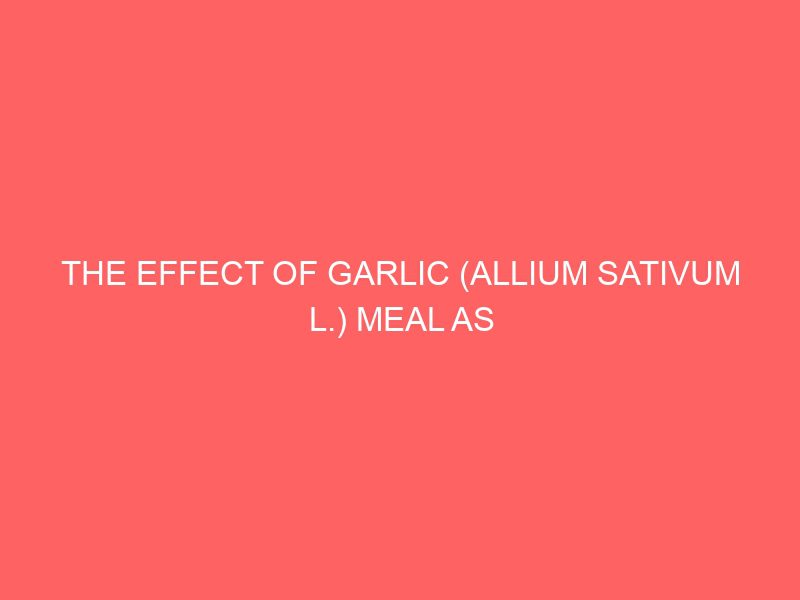Description
ABSTRACT
Four experiments were carried out to evaluate the effect of Garlic supplementation in broiler chickens. In the first experiments 0-4 weeks, a total of 270 day old broiler chicks were used for the experiment which had six treatments and three replicates, each replicate was allotted 15 birds in a completely randomized design. Six broiler starter diets were formulated such that (Diet 1) contains 0.01% of an antibiotic, Neocloxsin. For Diets 2, 3, 4, 5 and 6, Garlic meal was included at 1.00, 1.50, 2.00, 2.50 and 3.00% in the Diets respectively. In the 2ndExperiment 5-9 weeks, 180 birds from experiment 1 were used. The experiment had six Diets and three replicates each; each replicate was allotted 12 birds in a completely randomized design. Six broiler finisher Diets were formulated, they contained the same level of antibiotics and Garlic meal as in experiment 1. There was significant (P < 0.05) difference in the finial body weight, weight gain, feed intake, feed to gain ratio, feed cost per kg gain and mortality across dietary treatments. At the end of the starter and finisher phase of the experiment, 1.5% dietary level of garlic meal supplementation had a better feed conversion ratio and better live weight while the least was obtained on birds fed 3.0 % garlic inclusion.
In the third experiment, the best graded level (1.5 %) of garlic meal from experiment 1 and 2 were compared with different antibiotics (N.C.O, Embazine, Vitacox and two natural ingredients, Garlic meal and Moringa leaves). The Experimental diets consists of Diets 1, No Antibiotic, No Garlic meal and Moringa leaves, Diets 2-6 contained N.C.O (0.10 %), Embazin (0.10 %), Vitacox (0.10 %), Garlic (1.5%) and Moringa (1.5%) respectively. A total of 270 day old broilers chicks were used for the experiment which had six treatments and three replicates, each replicate was allotted 15 birds in a completely randomized design. The experiment lasted 0-4 weeks. There was significant (P < 0.05) difference in finial bodyweight gain and feed intake. Birds fed Garlic meal and Moringa leaves supplementation had the highest live weight of 810.6g and 799.07g which was statistically similar to birds on control, N.C.O and Embazine but significantly (P < 0.05) higher than birds on Vitacox. The least finial weight was observed for birds fed diets containing Vitacox (588.49g). In the 4th experiment, 180 birds from experiment 3 were used. The experiment had six Diets and three replicates each; each replicate was allotted 12 birds in a completely randomized design. Six broiler diets were formulated; they contained the same level of antibiotic, garlic meal and Moringa as in experiment 3. The experiment lasted 5-9 weeks. The results in experiment 4, there were no significant differences (P> 0.05) in feed intake, weight gain, feed to gain ratio and finial body weight across Diets, better body weight over control and other dietary treatment were obtained in birds receiving diet supplemented with garlic meal and Moringa leaves (treatment 5 and 6) No significant difference were observed in carcass percentage and internal organs between birds fed experimental diets. From these results 1.5% garlic and 1.5% Moringa inclusion level both in starter diets and finisher diets supported optimal performance and compared favorable well with conventional antibiotics.
CHAPTER ONE
INTRODUCTION
There is increasing pressure to reduce or eliminate the use of antibiotics in poultry feed due to the claimed negative effects on human health arising from antibiotic resistance. In the United States, poultry producers are faced with a national regulation that prohibits the use of antibiotics (USDA, 2005). This has left poultry producers looking for alternatives to antibiotics that are relatively cheaper and with minimal residual effect. Use of antibiotic that might result in deposition of residues in meat, milk and eggs must not be permitted in food intended for human consumption. If use of antibiotics is necessary as in prevention and treatment of animal diseases, a withholding period must be observed until the residues are negligible or no longer detected.







